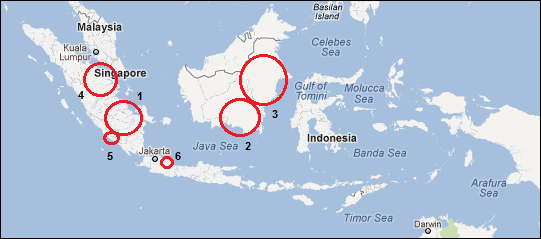Coalbed Methane
Coalbed methane (CBM) is a form of natural gas that occurs in coal beds. During the coalification process, large amounts of gas (mainly methane) are formed biologically in the coal deposits and released during coal extraction. Although CBM production is a complementary aspect of coal mining, it has only started to gain attention in recent years.
CBM holds great potential as a global resource because the world contains abundant reserves of this gas and - moreover - it is an environmental friendly fuel. Countries that contain large CBM reserves and are active in the production of this commodity are Russia, China, Alaska, Australia, Canada and the United States. Most of the world's reserves of CBM, however, remain untapped.
Coalbed Methane in Indonesia
Indonesia's CBM reserves are among the largest CBM reserves in the world. Currently, the country's reserves are estimated to be around 453 trillion cubic feet (tcf) which is equivalent to around six percent of total global CBM reserves (this estimate is an optimistic one and the scientific basis is questioned). This figure also implies that Indonesia's CBM reserves are more than double the country's natural gas reserves. However, Indonesia's utilization of this energy resource remains low.
Indonesia's largest CBM basins are located in:
1. South Sumatra
2. South Kalimantan
3. East Kalimantan
And some smaller basins can be found in:
4. Riau (Sumatra)
5. Bengkulu (Sumatra)
6. West Java (northern coastal area)

However, despite having ample reserves Indonesia has been slow to develop a commercial CBM industry (compared to its regional peers). One factor that explains slow development is uncertainty surrounding the legal and regulatory framework applicable to mining in Indonesia and CBM exploitation specifically. Currently, the Indonesian government uses a production-sharing contract scheme for CBM development that is similar to the scheme used in oil and gas blocks. This has drawn criticism as the non-conventional blocks are seen to have different characteristics. Under this production-sharing scheme, the nation's oil and gas blocks are owned by the government while companies are under contract to utilize the mineral resources. For the government this scheme is beneficial as all costs and risks are borne by the contractors. Only if the project is a success, then expenditure will be reimbursed (cost recovery system).
The first significant CBM project in Indonesia was the Sanga-Sanga field in East Kalimantan that was awarded - in 2009 - to a consortium in which BP and ENI hold large stakes. State-owned energy company Pertamina is also engaged the country's CBM industry through its subsidiary Pertamina Hulu Energi. Between 2008 and 2015 a total of 54 working areas, mainly around Sumatra and Kalimantan, for CBM development were granted by the Indonesian government. However, tapping the potential remains problematic. Bureaucratic inertia at both the central and local government continues to hamper exploration in the mining sector. Furthermore, the lack of suitable specialized drilling equipment also plays part in disappointing progress.
Initially, the government targeted CBM production at 500 million standard cubic feet per day (mmscfd) by 2015. However, this target was scaled down to 8.9 mmscfd. In 2014 CBM production stood at around 0.625 mmscfd.
The Indonesian government intends to uplift the role of renewable sources in the country's energy mix towards the future:
| Energy Mix 2011 |
Energy Mix 2025 |
|
| Oil | 50% | 23% |
| Coal | 24% | 30% |
| Gas | 20% | 20% |
| Renewable Energy | 6% | 26% |
Source: Ministry of Energy and Mineral Resources
